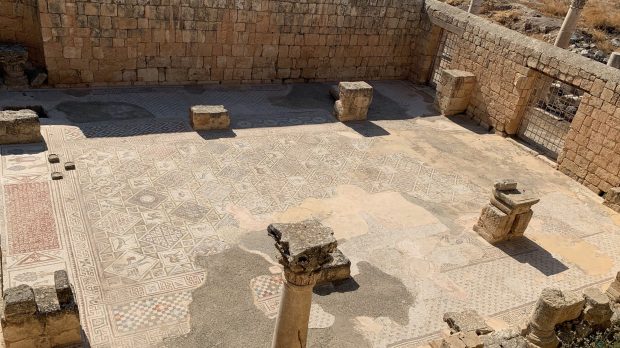Can you imagine yourself visiting the spot where, according to tradition, the prophet Elijah was taken up to Heaven; or the remains of an ancient Byzantine basilica built right next to his birthplace? “If I only knew where to find them!” you might think. Well, both tradition and archaeology provide with pretty convincing evidence that helps answer those questions.
Let’s take a look at the Gospels, first. Why would Christians be interested in the figure of the prophet Elijah, to begin with?
The Transfiguration, the event in which Jesus appears radiant in glory upon the mountain accompanied by Moses and Elijah, is minutely described in the Synoptic Gospels (Matthew, Mark, and Luke), mentioned in the second Epistle of Peter and, according to some, discreetly alluded to in John’s Gospel (“We have seen his glory, the glory of the one and only Son”), John being one of the three apostles who witnessed (with Peter and James) this miracle.
There is much discussion as to where this event took place, as the New Testament says nothing about where it occurred — early sources, like Origen, point at Mount Tabor, but more contemporary scholars say Mount Hermon. However, there is relatively little discussion regarding Elijah’s birthplace.
Biblical tradition claims the great prophet Elijah was born in Tishbe. The First Book of Kings presents Elijah as “Elijah the Tishbite.” According to the biblical text, Tishbe is located in Gilead, east of the Jordan river, in western Jordan. Tishbe has for a long time been identified as the historical town of Listib in Gilead, due to its location and the similarity between the ancient Hebrew name and the Arabic name, “El-Istib.” In fact, contemporary scholars and biblical archaeologists claim that this Tishbe-Listib might be one of three locations in the vicinity of Tell Mar Elias, also known as simply “Mar Elias,” a beautiful, green and fertile location where two Byzantine churches were erected in Elijah’s memory, in the 4th and 6th centuries respectively. The visitor can still admire the magnificent mosaics that remain there, and pilgrims from the three Abrahamic religions (Judaism, Christianity, and Islam) tie red ribbons to an oak tree, paying homage to the prophet.
But tradition also claims this is not only Elijah’s birthplace, but also the place from which he was taken up to Heaven, according to the biblical story that describes the events that took place after he and Elisha had just crossed the Jordan River. In the Second Book of Kings, one reads:
As they (Elijah and Elisha) were walking along and talking together, suddenly a chariot of fire and horses of fire appeared and separated the two of them, and Elijah went up to heaven in a whirlwind. Elisha saw this and cried out, “My father! My father! The chariots and horsemen of Israel!” And Elisha saw him no more. Then he took hold of his garment and tore it in two.
This “rapture” explains the presence of Elijah in Jesus’ Transfiguration. We can easily understand Moses’ presence. On the one hand, the Transfiguration occurs after Jesus feeds the hungry multitude, multiplying the loaves and fishes, which reminds us of the Israelites being fed with manna while led by Moses in the wilderness. Also, the Book of Exodus (34:29-35) tells us that when Moses came down from Sinai with the Ten Commandments “his face was radiant” (in fact, this passage is often referred to as “the radiant face of Moses”) just as Jesus’ face “shone like the sun” during his Transfiguration. These parallels would have surely been deeply and evidently meaningful not only for the authors of the Gospels, but also for their early readers.
Elijah’s relationship to the Transfiguration, however, is probably a bit less evident. Luke’s Gospel (9:28-36) adds that Jesus, Moses, and Elijah were speaking about his departure (that is, Jesus’), “which he was about to bring to fulfillment at Jerusalem.” The Greek word Luke uses for “departure” in the original is exodos, an obvious allusion to Moses’ exodus out of Egypt. Here, the author is offering a clear reading of the history of salvation as going from Moses’ liberation to that offered by Jesus. But what about Elijah, then?
Well, Elijah also “departed,” as we just read in the Second Book of Kings, Tel Mar Elias being the place this event occurred. In fact, Kings tells us the prophet did not die, but rather entered heaven alive “by fire,” “in a whirlwind,” carried away in a chariot of fire. Alongside Enoch and the Virgin Mary, he is the only other biblical character taken bodily into heaven. This passage is known as “Elijah’s departure,” and is also interpreted as a prefiguration of Jesus’ own Ascension into Heaven alive, once resurrected. It makes sense Elijah and Moses are then the two characters discussing Jesus’ own departure (“exodos”) as well.
Next time you’re thinking about a pilgrimage to the Holy Land, make sure you visit Elijah’s birthplace, and follow his path (both historical and spiritual) all the way to the River Jordan, where John the Baptist, “the Elijah that had to come,” baptized Jesus.

